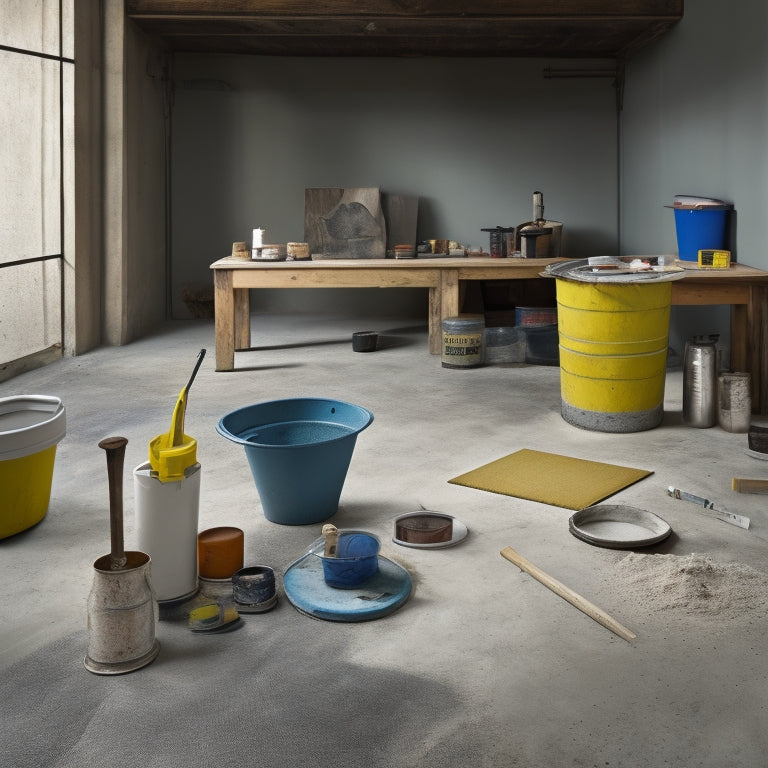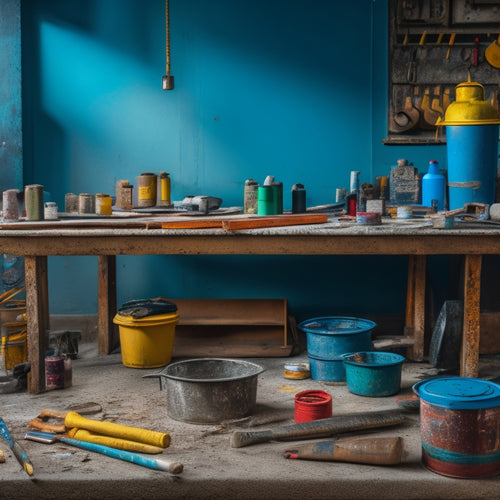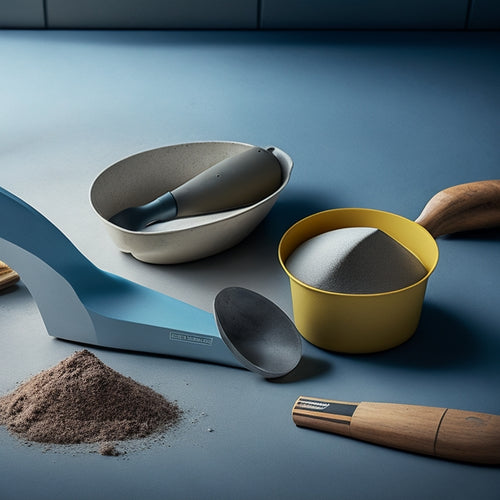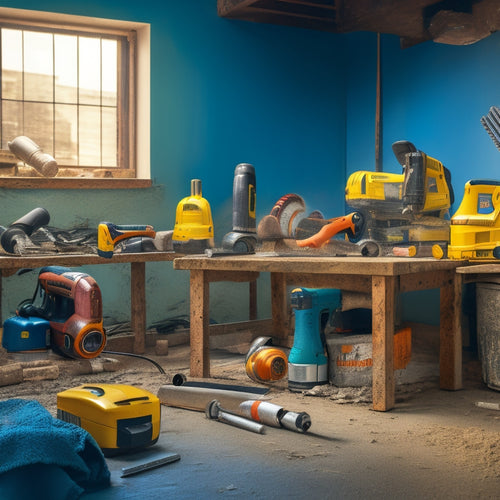
10 Essential Tools for Staining Concrete Floors
Share
To achieve a professional-looking finish on your concrete floor, you'll need to equip yourself with the right tools. Start with essential safety gear, including gloves, safety glasses, and a face mask, to protect yourself from harsh chemicals. Next, prepare your floor with a broom, pressure washer, and patching compound. Apply acid etching solution with a specialized applicator and choose the right brush or roller for your stain type. Consider sealant and coating sprayers, as well as tools for measuring, marking, and edging. Don't forget to test stain colors and finishes, and invest in high-quality cutting wheels and blades. As you continue to build your toolkit, you'll be well on your way to achieving a durable, beautiful finish.
Key Takeaways
• Safety gear, including gloves, safety glasses, and face masks, is essential to prevent skin and eye irritation and respiratory issues.
• A pressure washer and grinder or scarifier are necessary for proper concrete floor preparation to ensure a professional-looking finish.
• Specialized applicators, such as pump-up or handheld sprayers, are required for even distribution of acid etching solution and stain application.
• Sealant and coating sprayers, including airless, hopper, and HVLP sprayers, are necessary for quick and uniform coverage.
• Regular maintenance of sprayers and cleaning equipment, such as daily inspections and weekly disassembly, is crucial to prevent equipment failure and ensure a high-quality finish.
Safety Gear and Protective Wear
When working with concrete stain, you'll need to wear essential safety gear and protective wear to prevent skin and eye irritation, as well as respiratory problems. This is vital, as concrete stain can contain harsh chemicals that can cause serious health issues if not handled properly.
To meet safety standards, you'll need to don protective equipment such as gloves, safety glasses, and a face mask. These will shield you from skin contact and inhalation of harmful fumes.
Additionally, wearing long-sleeved shirts, pants, and closed-toe shoes will provide extra protection against skin irritation. It's also important to guarantee good ventilation in the work area to prevent the buildup of fumes.
Concrete Floor Preparation Tools
To achieve a successful concrete stain application, you'll need to ascertain the floor is properly prepared, which requires the right tools to clean, repair, and profile the surface. As a DIYer or contractor, you'll want to invest in the essential tools for concrete floor preparation to guarantee a smooth and even finish.
| Tool | Purpose |
|---|---|
| Broom or Blower | Remove debris and dust from the surface |
| Pressure Washer | Clean the floor thoroughly, removing dirt and grime |
| Patching Compound | Repair cracks and imperfections in the concrete |
| Grinder or Scarifier | Profile the surface, creating a rough texture for better stain adhesion |
These surface preparation techniques are vital for achieving a professional-looking finish with your concrete flooring materials. By using the right tools, you'll be able to create a smooth, even surface that's ready for staining. Remember, proper preparation is key to a successful stain application, so don't skimp on the prep work. With the right tools and techniques, you'll be able to achieve a beautiful, long-lasting finish.
Acid Etching Solution Applicators
You'll need to apply an acid etching solution to open up the concrete's pores and confirm ideal stain penetration. For this crucial step, you'll require specialized applicators. Acid etching solution applicators are designed to evenly distribute the solution across the concrete surface, assuring consistent penetration and best surface preparation.
When selecting an applicator, consider the type of acid etching solution you're using and the size of your concrete floor. A pump-up sprayer or a handheld sprayer is perfect for small to medium-sized floors, while a larger floor may require a walk-behind sprayer or a ride-on sprayer.
To achieve the best results, it's vital to master the application techniques for acid etching solution. Start by dividing your floor into sections, and work in a well-ventilated area to prevent inhaling fumes.
Use a steady, back-and-forth motion to apply the solution, working in small sections to maintain even coverage. Allow the solution to dwell for the recommended time, then thoroughly rinse the floor to remove any residue.
Stain Application Brushes and Rollers
Stain application brushes and rollers play a critical role in achieving an even, uniform stain coat by effectively transferring the stain to the concrete floor. When selecting a brush or roller, consider the type of stain you're using and the desired finish.
Natural bristle brushes are ideal for acid-based stains, while synthetic brushes work better with water-based stains. You'll also need to choose the right brush type: flat brushes for broad, open areas and angled brushes for corners and edges.
Rollers, on the other hand, are perfect for large, open areas and can be used with extension poles for added convenience. Microfiber rollers are a popular choice due to their ability to hold a lot of stain and apply it evenly.
When it comes to application techniques, you'll want to work in sections, using overlapping strokes to guarantee uniform coverage. Apply the stain in a consistent, back-and-forth motion, maintaining a wet edge to prevent lap marks.
Sealant and Coating Sprayers
When it comes to applying sealants and coatings to your stained concrete floor, you'll need a reliable sprayer to guarantee a smooth, even finish.
You'll have a choice between different types of sprayers, each with its own strengths and weaknesses, which we'll explore in detail.
Types of Sprayers
Selecting the right sprayer for your concrete floor staining project is essential, as it directly impacts the quality of the sealant or coating application and its subsequent performance. You'll want to choose a sprayer that can efficiently and evenly apply the desired amount of material to achieve the desired finish.
When it comes to types of sprayers, you have several options to evaluate:
-
Airless sprayers: These sprayers use high pressure to atomize the material, creating a fine mist that can cover large areas quickly. Ideal for applying thin coats and achieving a uniform finish.
-
Hopper sprayers: These sprayers use compressed air to force material out of a hopper, which can be refilled as needed. Great for applying thicker coats and working with heavier materials.
-
HVLP (High Volume, Low Pressure) sprayers: These sprayers use a combination of air and material to create a high-volume, low-pressure spray pattern. Suitable for applying thin to medium coats.
-
Electrostatic sprayers: These sprayers use an electrostatic charge to attract the material to the surface, reducing overspray and increasing efficiency. Often used for applying thin coats and achieving a smooth finish.
-
Handheld sprayers: These sprayers are small, portable, and easy to use. Ideal for small areas, touch-ups, and detail work.
Sprayer Maintenance Tips
To guarantee peak performance and extend the lifespan of your sprayer, you'll need to establish a regular maintenance routine, regardless of the type you've chosen for your concrete floor staining project. This includes daily, weekly, and monthly tasks to assure your sprayer operates efficiently and accurately.
Daily, inspect your sprayer for signs of wear and tear, checking for clogs, blockages, and worn-out seals. Clean the nozzle and tip regularly to prevent paint buildup, and flush the system with solvent to remove any residue.
Weekly, disassemble the sprayer and soak the components in a cleaning solution to remove dried stain and coating material. Reassemble the sprayer, ensuring all parts are securely tightened.
Monthly, inspect and replace worn-out seals, O-rings, and gaskets. Also, consider nozzle selection, as different nozzle types are designed for specific sprayer types and stain viscosities.
Proper maintenance will prevent issues like uneven coverage, tip clogs, and equipment failure, assuring a flawless stain application and saving you time and resources in the long run.
Concrete Floor Cleaning Equipment
You'll need a reliable concrete floor cleaning equipment setup, consisting of a heavy-duty floor scrubber and a wet vacuum, to thoroughly remove dirt and grime before applying a stain. This equipment is vital for effective concrete cleaning techniques and will help you achieve a professional-looking finish.
Here are the essential components of your concrete floor cleaning equipment setup:
-
A ride-on or walk-behind floor scrubber with a stiff-bristle brush or pad to aggressively remove dirt and grime
-
A wet vacuum or extractor to pick up dirty water and debris
-
A pressure washer with a wide fan tip to reach large areas quickly
-
A floor cleaning solution specifically designed for concrete floors
-
A microfiber mop or cleaning pad for detailed cleaning and edge work
Investing in commercial cleaning equipment will pay off in the long run, as it will help you complete the job efficiently and effectively.
With the right equipment, you'll be able to tackle even the toughest concrete cleaning jobs with confidence.
Stain Color and Finish Samples
Your concrete floor staining project requires an essential step: evaluating stain color and finish samples to confirm the desired aesthetic and durability. This vital step guarantees you achieve the perfect hue and sheen for your floor. By testing samples, you'll avoid costly mistakes and confirm the final result meets your expectations.
| Stain Color Options | Finish Durability |
|---|---|
| Earthy Brown | High-gloss, scratch-resistant |
| Rich Grey | Matte, low-sheen, slip-resistant |
| Vibrant Red | Semi-gloss, moderate durability |
| Soft Beige | Flat, low-maintenance |
| Deep Blue | High-gloss, high-traffic resistant |
When evaluating samples, consider factors like color selection, finish durability, and the level of traffic your floor will endure. Remember, the finish you choose will impact the overall appearance and longevity of your stained concrete floor. Take your time, and don't hesitate to ask for professional guidance if needed. By doing so, you'll be confident in your final selection, guaranteeing a stunning and long-lasting result.
Floor Measuring and Marking Tools
Measure the length, width, and layout of your concrete floor space to determine the number of sections you'll need to stain. Prepare to mark boundaries and patterns with precision using specialized tools. To achieve accurate measuring techniques, you'll need the right floor measuring and marking tools. These tools will help you create a precise plan for your staining project, guaranteeing a professional-looking finish.
Here are the essential tools you'll need:
-
A 100-foot tape measure for calculating the total square footage of your floor
-
A laser level for establishing a level reference point and detecting any deviations
-
A chalk line reel for creating straight lines and boundaries
-
A marking gauge for creating consistent, precise markings
-
A concrete floor marker for making temporary marks on the floor
With these tools, you'll be able to accurately measure your floor space, mark boundaries and patterns, and guarantee a successful staining project. By using the right measuring and marking methods, you'll achieve a beautifully stained concrete floor that meets your design vision.
Edging and Cutting Accessories
As you prepare to stain your concrete floor, you'll need to guarantee precise edging and cutting to achieve a professional-looking result.
To do this, you'll want to equip yourself with the right edging and cutting accessories, including edge control systems that help you maintain a steady hand.
Edge Control Systems
When staining concrete floors, you'll need edge control systems to achieve clean, precise cuts and prevent unwanted color bleeding beyond the designated area.
Edge control benefits include improved aesthetics, enhanced durability, and reduced maintenance. By mastering edge finishing techniques, you can create crisp, defined edges that showcase your design vision.
To achieve professional-grade results, consider the following essential edge control systems:
-
Edge guides: Attach to your grinder or saw to maintain a consistent distance from the wall or other obstructions.
-
Edge wheels: Designed for precise cutting and trimming, these wheels feature diamond-coated edges for maximum durability.
-
Edge shields: Protect adjacent surfaces from color bleeding and stains with these flexible, adhesive-backed shields.
-
Edge clamps: Securely hold edge guides or shields in place, ensuring accurate cuts and preventing slippage.
-
Edge finishing tools: Use these specialized tools to refine and polish edges, creating a seamless connection between concrete and adjacent surfaces.
Cutting Wheel Options
You'll need to select the right cutting wheel options from a range of edging and cutting accessories to effectively cut and shape your concrete floor, ensuring precise control and a professional finish.
When choosing a cutting wheel, consider the type of concrete you're working with, as well as the desired finish. There are various cutting wheel types to choose from, including diamond-coated, abrasive, and silicon carbide wheels. Each type is suited for specific applications and provides distinct advantages. Diamond-coated wheels, for instance, are ideal for aggressive cutting and heavy-duty applications, while abrasive wheels are better suited for lighter, more precise cuts.
The cutting wheel materials you select will also impact your results. Wheels made from high-quality materials, such as industrial-grade diamonds or advanced ceramics, will provide a more precise cut and longer lifespan.
Additionally, consider the wheel's bond strength, as this will affect its ability to effectively cut through concrete. By selecting the right cutting wheel options, you'll be able to achieve the precise control and professional finish you desire for your stained concrete floor.
Blade Selection Guide
Selecting the right blade from the array of edging and cutting accessories is essential to achieving precise cuts and shapes in your concrete floor, especially after choosing the ideal cutting wheel.
You'll want to take into account the specific tasks you need to accomplish and the type of concrete you're working with to make an informed decision.
Here are some key factors to keep in mind when selecting a blade:
-
Diamond-coated blades for aggressive cutting and longer lifespan
-
Segmented blades for faster cutting and reduced heat buildup
-
Continuous rim blades for smooth, precise cuts and minimal chipping
-
Turbo blades for increased speed and versatility
-
Abrasive blades for grinding and polishing concrete surfaces
When it comes to blade maintenance, regular cleaning and inspection are vital to extend the life of your blade.
Look for blades made from high-quality materials that can withstand the demands of concrete cutting and edging.
Additionally, take into account the compatibility of your blade with your cutting wheel and other equipment to guarantee seamless integration.
Finishing and Polishing Machines
Operate a walk-behind grinder or a ride-on floor grinder to aggressively remove imperfections and flatten the concrete surface, preparing it for the polishing process. These machines are essential for achieving a smooth, even finish.
As you work, you'll employ various finishing techniques to refine the surface. For instance, you might use a coarse grit to remove surface defects, followed by progressively finer grits to hone the concrete.
Next, you'll switch to polishing methods that bring out the desired level of shine. This may involve applying a polishing compound, such as a diamond abrasive or a chemical polish, to the grinder.
You'll need to carefully control the machine's speed, pressure, and movement to avoid scratching the surface. As you progress, you'll shift to higher-gloss polishing methods, such as burnishing or crystallization, to achieve the desired finish.
Remember to regularly inspect the floor's progress, adjusting your techniques as needed to achieve the best result.
With the right finishing and polishing machines, you'll be able to reveal the full beauty of your stained concrete floor.
Frequently Asked Questions
Can I Stain Concrete Floors With Radiant Heating Installed Underneath?
You're wondering if you can stain concrete floors with radiant heating installed underneath. The answer is yes, but you'll need to take extra precautions.
Since radiant heating can affect staining techniques, make sure the heating system is turned off during the staining process.
Additionally, choose a stain that's compatible with the radiant heating system and follow the manufacturer's instructions.
With proper preparation and planning, you can achieve a beautiful, stained concrete floor that complements your radiant heating system.
How Long Does It Take for Stained Concrete to Fully Cure?
When you apply a concrete stain, you'll want to know how long it'll take to fully cure.
The curing time typically ranges from 24 hours to 30 days, depending on the specific product and environmental conditions.
To guarantee ideal stain longevity, wait at least 24 hours before applying a sealant, and 30 days before exposing the floor to heavy traffic or harsh chemicals.
Is It Possible to Stain Concrete Floors With Existing Coatings?
You're probably aware that nearly 75% of concrete floors have some type of existing coating.
Now, can you stain concrete floors with those coatings still in place? Unfortunately, the answer is no.
You'll need to remove those coatings using specialized techniques and tools to guarantee a successful stain job.
Proper preparation techniques, including coating removal, are essential to achieving a strong bond between the stain and the concrete.
Can I Stain Concrete Floors in Cold Weather Conditions?
When you're planning to stain concrete floors in cold weather conditions, you'll need to take extra precautions.
Cold weather preparation is essential, as low temperatures can greatly impact the staining process. The ideal temperature range for staining is between 50°F and 80°F (10°C and 27°C).
If it's too cold, the stain may not penetrate evenly, resulting in an inconsistent finish.
You'll need to make sure the floor is dry, free of moisture, and at a stable temperature to achieve the best results.
Are Stained Concrete Floors Resistant to Scratches and Fading?
When you stain your concrete floors, you'll be pleased to know they're quite resistant to scratches and fading.
The stain durability is impressive, especially when you follow proper maintenance tips.
For instance, you should regularly clean the floors with a mild detergent and dry them thoroughly to prevent water spots.
Additionally, consider applying a concrete sealer to enhance the stain's resistance to wear and tear.
Conclusion
With these 10 essential tools in your arsenal, you're ready to release your creativity on that blank canvas of concrete.
Like a master chef seasoning a signature dish, you'll carefully balance acid etching, staining, and sealing to serve up a floor that's both functional and visually stunning.
Now, get ready to transform that dull, grey concrete into a vibrant work of art that'll leave a lasting impression on anyone who walks through the door.
Related Posts
-

Essential Tools for Painting Concrete Walls
When painting concrete walls, you'll need a range of specialized tools to achieve a professional-looking finish. Star...
-

Ergonomic Concrete Tools for Tight Spaces
When you're tackling concrete work in tight spaces, ergonomic tools are your best bet for comfort and efficiency. The...
-

Essential Power Tools for Concrete Block Construction
When building with concrete blocks, you'll need a range of power tools to cut, drill, mix, and finish the blocks to g...


